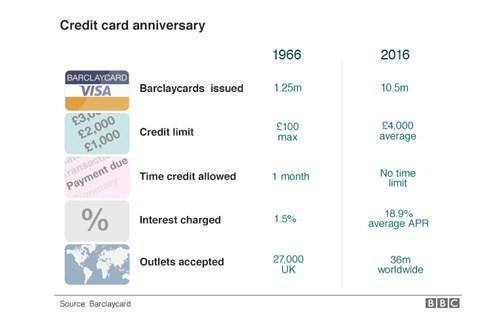 数据
数据Imagine strolling into your local supermarket, popping your essentials into a basket, heading to the bagging area - where no items are unexpected - and walking out with your weekly shop。
想象一下,当你漫步在附近的超市,把你的日常用品“啪”的一下扔到篮子里,再前往装袋区,然后把你每周的寻常消耗品带出超市即可。
There is no need to make a payment, no fiddling with coins, and no placement of a debit or credit card in a terminal。 In fact, there is no till at all。
在这个过程中,付款是冗余的:既不需要摆弄硬币,也没有地方把信用卡或者借记卡放在pos机终端。事实上,根本就没有付款柜台。
This is not casual shoplifting but a realistic prospect of the future way to pay - when technology recognises your presence, scans your shopping, and invisibly takes payment from your account。
以上过程并非偶然的偷窃,而是对未来支付方式的合理展望:科技手段可以识别出你的存在,并扫描出你的购物品,从而在无形中帮助用户在帐户里扣钱支付。
Amer Sajed, the chief executive of Barclaycard, says it will spell the steady demise of the physical plastic credit card, which his company introduced to the UK 50 years ago。
巴克莱银行的首席执行官Amer Sajed指出,新的支付方式意味着传统塑料信用卡的逐步消亡,这种基于物理介质的信用卡正是巴克莱银行50年前引入英国的。
“People will be able to seamlessly shop going between the web, an app or in store,” he says
他说:“人们将能够在网上,app以及实体店里进行衔接完美的购物。
It will also create a battle for control of your digital wallet between banks and technology companies, as well as prompt debate over our privacy and security。
银行和推出隐性支付的公司将为用户数字钱包的控制权而展开争夺。个人隐私和帐户安全等潜在问题也将迅速引起争论。
Credit cards have evolved since 1966, but the basic procedure of payment has remained the same。 A card is either handed over, or the number on it is read out or entered into a machine。
从1966年起信用卡就一直在进化,但是核心支付过程却从未变过:人们要么把卡手把手地交给售货员,要么将卡塞进机器,读取上面的数字和信息。
All that requires the existence of a plastic card, but Mr Sajed says this is being replaced by wearable items。
这样的交易过程仅仅需要一张塑料卡,但是Sajed先生说这些将被可穿戴设备所取代。
At a display for Barclaycard staff, he shows off a plastic ring, a bracelet and a keychain which all contain a chip allowing the shopper to make payments on credit。
在对巴克莱银行员工的展示中,他展示了塑料指环,项链以及钥匙环,这些都包括了可以让购物者通过信用卡支付的芯片。
This, he says, is just a bridge to technology that will see customers identified by their eye or fingerprint, located via their smartphone, and able to shop without queuing up at a checkout。
他说通过这样的途径,高科技可以利用眼睛和指纹识别分辨顾客,同时也可以利用智能手机来定位出顾客的位置。这样在购物时就不需要在收银台前排队。
Although cash, cheques and indeed cards will remain an option for shoppers, he says, these new ways of paying will take a growing share of the payments market in 10 years’ time。
尽管现金、支票以及信用卡将会仍然成为顾客支付的选择,他说这种可穿戴式的支付手段将在10年内逐渐占据更大的市场份额。
Such a prospect sounds frightening for anyone who already has concerns about corporations, and potentially hackers, tracking our whereabouts or spending habits。
这样的前景将使那些已经对现在的企业漏洞和潜在的黑客威胁深感不安的人们更加忧虑,因为这将可以追踪人们的去向和消费习惯。
Mr Sajed argues that nothing will be done without permission。
Sajed先生反驳说除非消费者授权,否则什么都不会做。
“We would never track anyone’s location or data without their express knowledge。 and it would only be for things that the customer has allowed us to do。”
他指出只有在消费者明确知道自己被定位的情况下,信用卡公司才会追踪和定位消费者的信息,并且这将只会用于消费者允许信用卡公司所处理的事务中。
There is an extra benefit, he says, as it is much easier to authorise a transaction when a card company knows a customer’s location。 It is easier to stop fraud for the same reason。
他认为这还有一项额外好处,即如果信用卡公司能够通过掌握消费者所在的位置,那么它们将可以更便捷的批准一项交易,并且可以预防诈骗。
A link in the background between the individual and the payment system is required for any of this to work。 This already happens with shopping portals like Amazon and services such as Uber allowing a single-click transaction because bank or credit card details are loaded when the customer first signs up。
对于新的支付系统来说,把个人和支付系统相连的后台也是必不可少的。这样的后台连接在购物或者服务平台上已经实现,比如说亚马逊和优步公司。它们允许顾客在登陆后将银行或信用卡信息进行捆绑,从而使得顾客只需点击一下即可完成交易。
“These emerging technologies still use the existing, underlying rails of the card payments system,” says Richard Koch, head of policy at the UK Cards Association
“这项新的技术其实还是沿用了已经存在的支付卡交易系统”,来自英国信用卡协会的Richard Koch先生说。
As this digital market becomes more prevalent, and the technology advances, there will be a battle among banks, payment providers and others for their product to be used。
随着数字交易市场的流行和科技的进步,银行、支付手段供应商以及其他提供支付手段产品的平台将势必会有一场恶战。
The UK Cards Association predicts there will be almost 21 billion “card” transactions in the UK in 2025, up from 12.6 billion last year。 Of these, 3.6 billion will be credit card purchases compared with 2.5 billion last year。
英国信用卡协会预测,英国在2025年将会有210亿广义的信用卡交易,而这一数字在去年则是126亿。其中信用卡购买频率将从去年的25亿增加到36亿。
责任编辑:王淳





































































































